TED-Ed
Cambridge Ideas - How Many Lightbulbs?
Humans have become addicted to fossil fuels. From pumping oil into our cars, to burning natural gas to heat our water, or using coal to create electricity that lights our homes, we are constantly relying on these nonrenewable resources....
Bill Nye
Bill Nye The Science Guy on Wind
Heating and spinning of our planet are what generate wind. A very large tank is used to model the phenomenon of convection, which is explained by Bill, but never specifically mentioned. If you show this mini movie to your meteorology...
PBS
Wind Power
Wind power blows non-renewable sources away! Why are there not more wind power plants? Science sleuths track down the reasons behind our limited use of wind energy with a video from NOVA's energy unit. The resource covers the storage and...
Crash Course
Humans and Energy: Crash Course World History 207
Is flipping a switch and lighting up a room normal or miraculous? It depends where—and when—you live. Crash Course World History covers historical uses of energy, current uses of energy, and the possible future uses of energy with an...
Curated OER
Electricity From All Kinds of Renewable Sources
On a bold, computer-generated animation of a landscape appears a city, power plants, wind turbines, and smaller, decentralized combined heat and power (CHP) plants. The intent is to show how CHP plants can be incorporated into the energy...
California Academy of Science
Renewable Energy: Clean Tech Solutions
Renewable energy originally found application more than 790,000 years ago. A relevant and engaging lesson explains some of the current options for renewable energy. Technology changes quickly and many different options provide hope for...
DoodleScience
Renewable Energy Resources: Part 1
Non-renewable resources will not last forever, so what are the next steps when it comes to energy? Luckily, renewable energy resources exist to create our electricity. The video explains how wind and water energy can be transferred to...
Crash Course
The Engineering Challenges of Renewable Energy: Crash Course Engineering #30
How hard is it to incorporate renewable energy resources? An informative video first describes renewable energy, such as hydropower, wind energy, geothermal energy, and solar power. It then explains the benefits and the challenges of...
PBS
Global Winds
Blow budding scientists away with a lesson that'll put wind in their sails! Scholars study the pattern of global winds using an interactive from PBS' Weather and Climate series. Detailed simulations help viewers study upper-level winds...
TED-Ed
What is an Aurora?
An impressive animation explains the earth's awe-inspiring auroras. The contributions of high-energy particles from the sun collide with our neutral atmospheric atoms. Explained are the roles of solar wind, plasma, the magnetosphere,...
PBS
Solving the Storage Problem
Clean, renewable energy is there for the taking ... how do we save it until we need it? A short video, part of an energy unit from NOVA, discusses the challenges of creating and storing electrical energy efficiently. The narrator...
Bozeman Science
ESS2D - Weather and Climate
Where does our weather come from? A thorough video lesson discusses the NGSS standard ESS2D instruction from elementary through high school. The instructor explains the factors the impact weather and climate and the long-term effects of...
MinuteEarth
Our Atmosphere is Escaping!
Our atmosphere keeps us from the extreme temperatures experienced on the moon. The video explains that our atmosphere actually leaks. It describes exactly which molecules escape and the multiple factors that contribute.
NASA
The Water Cycle: Steaming the Air
How does water vapor move from point A to point B? The second installment in a series of four on the water cycle allows scholars to analyze satellite images to answer this question. The satellite animations show how evaporation and wind...
NASA
The Water Cycle: Watering the Land
The oceans contribute 37 trillion tons of water to land masses in the form of rain and snow. The third in a four-part series from NASA show satellite animations highlighting the precipitation on Earth. The videos show the movement of the...
PBS
The Ocean: A Driving Force for Weather and Climate
What's behind Earth's wild, wonderful, and sometimes weird weather? A lesson from PBS's Weather and Climate series takes viewers on a worldwide trek to examine the many interactions between Earth's atmosphere, oceans, and land masses....
Periodic Videos
Terbium
Terbium finds applications in hybrid cars and wind turbines—very important in today's quest to discover energy solutions! Learn more about this lanthanide in an episode from a series about each of the element on the periodic table. A...
Scholastic
Study Jams! Electricity
Shock your physical science class using this video to teach the basics of static electricity. Electricity is defined,and electrons are differentiated from protons on an atom model. The use of hydropower and wind are explained as ways of...
MinuteEarth
Ocean Confetti!
Microplastics exist in our oceans from the Arctic to the Antarctic. Polluting the ocean with plastics creates these microplastics that are so durable they do not break down into organic materials. The video points out that scientists...
Crash Course
Skyscrapers, Statics, and Dynamics: Crash Course Engineering #26
You definitely don't want skyscrapers to sway too much. An informative video discusses statics and dynamics, equilibrium, forces, and torque. It uses the Citicorp Building as an example to illustrate the danger of quartering winds and...
Howard Hughes Medical Institute
How We Get Our Skin Color Interactive
I can see your epidermis. A short video shows how we get our skin color. It explains how melanocyte cells in the epidermis produce melanin, and that the type and amount of melanin controls skin color.
Crash Course
Nebulae
A star is born! Introduce young astronomers to the characteristics of nebulae in a narrated video. Discover what they are made of, why some reflect light and others glow on their own, and the locations of several notable nebulae. The...























